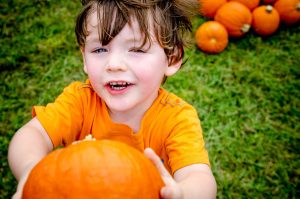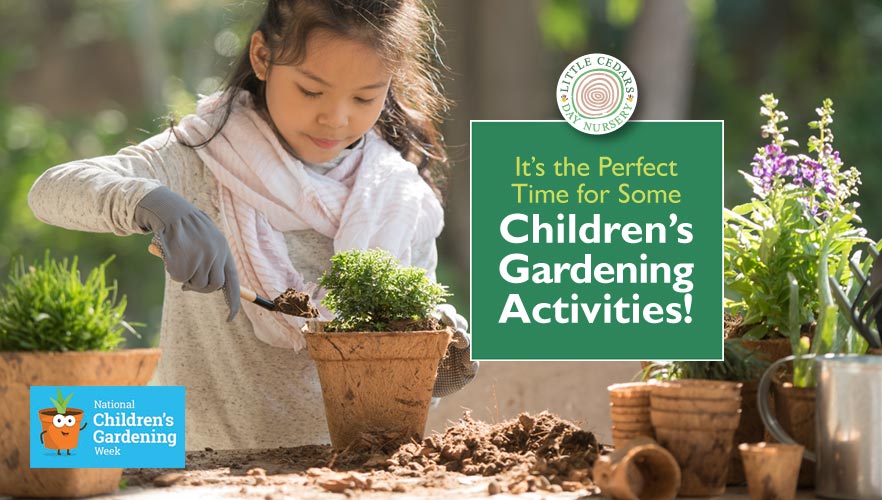
At the time of publishing this article, many UK children are enjoying National Children’s Gardening Week. At this time of year, the weather is sunnier more often, so it’s the perfect time to involve children in gardening activities. Whether taking part in the event or not, gardening is a fun, educational activity for children — and will also help to make the world a better place! So, if you would like to introduce your child to gardening and all that it has to offer little ones, read on as we tell you about some gardening activity ideas that little ones can take part in now and at any time during the warmer months of the year.
National Children’s Gardening Week
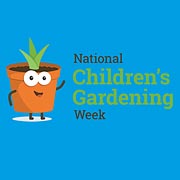 National Children’s Gardening Week takes place each year in the UK during what’s known as the ‘warm week’ beginning right at the end of May. This year (2024) it spans from 25 May to 2 June. However, children can get involved in gardening well outside of those dates*, of course.
National Children’s Gardening Week takes place each year in the UK during what’s known as the ‘warm week’ beginning right at the end of May. This year (2024) it spans from 25 May to 2 June. However, children can get involved in gardening well outside of those dates*, of course.
The annual gardening event for children started in the north of England but now takes place across the whole Nation and, like the plants and flowers in the gardens, its popularity is growing. Indeed, children are taking part at home, in schools, and at childcare settings like nurseries and preschools. In turn, the initiative itself supports the Greenfingers charity, which provides wonderful gardens and outdoor spaces for children in hospices.
* Children Can Garden Any Time in the Warmer Months
Late spring and the summer months in particular make things much easier for children to learn about gardening as there’s negligible chance of frost occurring. Warmer weather makes gardening easier and less complicated for them because, when it’s warm, there is no need to protect plants and seedlings from adverse weather conditions. What’s more, gardening results are much faster during the warmer months of the year, so even less patient children can remain engaged. That said, patience is something every child will have to learn, so a little waiting for results is a good lesson to learn.
Gardening Activities for Children
There are many fun gardening-related activities for children to do during the warmer months. Here are a few ideas to get children and families started.
Grow with Peter Rabbit Activities
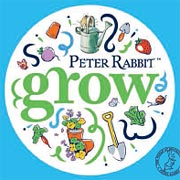 This year (2024), National Children’s Gardening Week has teamed up with The World of Peter Rabbit and is encouraging children and their families to Grow With Peter Rabbit! Free activity booklets for the initiative can be downloaded here. The dozen or so pages in this year’s activity booklet include 9 gardening-related activity ideas for children to take part in. Activities include anything from growing a windowsill herb garden and creating leaf-print cards to more simple tasks like solving garden-related pictorial puzzles. Download the activity booklet using the bold link above.
This year (2024), National Children’s Gardening Week has teamed up with The World of Peter Rabbit and is encouraging children and their families to Grow With Peter Rabbit! Free activity booklets for the initiative can be downloaded here. The dozen or so pages in this year’s activity booklet include 9 gardening-related activity ideas for children to take part in. Activities include anything from growing a windowsill herb garden and creating leaf-print cards to more simple tasks like solving garden-related pictorial puzzles. Download the activity booklet using the bold link above.
Wildflower Growing Activity
 A quick and easy outdoor activity for children is to sow and grow wildflowers (follow the bold link for much more information about this simple but worthwhile activity). Once growing and flowering, wildflowers will brighten up the garden and also attract important pollinators like bees and butterflies. What’s more, this activity is possible using just flower pots or grow bags on a patio or balcony if you don’t have access to a garden. You can also download our free butterfly reference poster for children here.
A quick and easy outdoor activity for children is to sow and grow wildflowers (follow the bold link for much more information about this simple but worthwhile activity). Once growing and flowering, wildflowers will brighten up the garden and also attract important pollinators like bees and butterflies. What’s more, this activity is possible using just flower pots or grow bags on a patio or balcony if you don’t have access to a garden. You can also download our free butterfly reference poster for children here.
Make Simple Bird Feeders
 Did you know, there are some incredibly easy ways for children to make home-made bird feeders? Follow our guide and you’ll soon see how children can make bird feeders from something as simple as a pine cone or even a recycled milk carton. Take a look via the link and get ready to welcome some lovely birds to your patch. Indeed, bird spotting is all part of the fun (download our free bird-spotting poster here).
Did you know, there are some incredibly easy ways for children to make home-made bird feeders? Follow our guide and you’ll soon see how children can make bird feeders from something as simple as a pine cone or even a recycled milk carton. Take a look via the link and get ready to welcome some lovely birds to your patch. Indeed, bird spotting is all part of the fun (download our free bird-spotting poster here).
Composting Activity
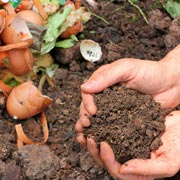 Composting is another hugely worthwhile activity for children to take part in, even right up into the Autumn. It’s easy and a great way to ecologically dispose of waste like egg shells, vegetable peelings, and garden waste like grass cuttings. What’s more, once complete, the household will have a ready supply of nutrient-rich compost that will enrich and feed flowers and plants in the garden or flower pots on the windowsill.
Composting is another hugely worthwhile activity for children to take part in, even right up into the Autumn. It’s easy and a great way to ecologically dispose of waste like egg shells, vegetable peelings, and garden waste like grass cuttings. What’s more, once complete, the household will have a ready supply of nutrient-rich compost that will enrich and feed flowers and plants in the garden or flower pots on the windowsill.
Minibeast Spotting
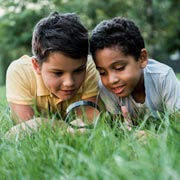 Compost heaps are also wonderful homes for minibeasts, which are also fun and educational for children to spot. Use our previously published free Minibeast Reference Poster to learn how to recognise some of the common minibeasts that might be hiding in gardens, under pots, and in compost heaps around Britain.
Compost heaps are also wonderful homes for minibeasts, which are also fun and educational for children to spot. Use our previously published free Minibeast Reference Poster to learn how to recognise some of the common minibeasts that might be hiding in gardens, under pots, and in compost heaps around Britain.
Wildlife-Friendly Gardening
Try to teach your children how to make gardens wildlife-friendly (whether in back gardens or smaller spaces like patios and balconies). Ensure children understand that wildlife like bees and other flora and fauna are under threat from nasty chemicals and habitat loss.  So, making a wildlife-friendly garden or area is a very worthwhile activity for children to take part in — and is educational on so many levels. See our separate guide to wildlife-friendly gardening for kids, try some of the ideas above, or download this free wildlife-friendly activity pack.
So, making a wildlife-friendly garden or area is a very worthwhile activity for children to take part in — and is educational on so many levels. See our separate guide to wildlife-friendly gardening for kids, try some of the ideas above, or download this free wildlife-friendly activity pack.
Indoor ‘Gardening’ Activities for Kids
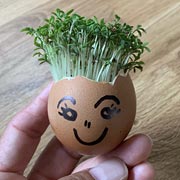 Children can do ‘gardening’ activities indoors too! Get them to try making egg cress heads, for example. It’s an easy, fun activity and children will love the results!
Children can do ‘gardening’ activities indoors too! Get them to try making egg cress heads, for example. It’s an easy, fun activity and children will love the results!
Did you know that children can also grow food from scratch indoors? They’ll love growing microgreens indoors and it can also be done on a windowsill. Not only will it be fun and educational for the children, but they’ll also be able to eat the results! Learn more about growing microgreens indoors here and learn more about the benefits of teaching children to grow food here.
More Gardening Ideas for Kids
More gardening-related activities for children can be found here. At the bottom of that page, you can also use the ‘older entries’ link to discover even more ideas.
Gardening is also a great way to introduce children to the concept of sustainability, ecological matters, and the need to protect both the environment and the planet as a whole. After all, we only have one planet and our children and grandchildren will eventually be in charge of its stewardship. Find out about some additional sustainable gardening activities that children can take part in here.
Why Gardening is Such a Worthwhile Activity for Children
 The benefits of gardening for children are many and varied and that’s why it’s such a wonderful activity to get them involved in. It will teach children many new skills and new knowledge. It’ll teach them about the circle of life, how to care and be responsible for other living things, and about the importance of looking after the planet. It will also give them an insight into where some food types come from. It is also great fun, will give children a huge sense of achievement, and may even open their eyes to the possibility of careers in horticulture, land management, food production, farming, and the like. And, of course, gardening makes the world a better place in so many ways. Let’s also not forget that being around nature is hugely beneficial to children, but do remember to follow good safety precautions when children are outdoors.
The benefits of gardening for children are many and varied and that’s why it’s such a wonderful activity to get them involved in. It will teach children many new skills and new knowledge. It’ll teach them about the circle of life, how to care and be responsible for other living things, and about the importance of looking after the planet. It will also give them an insight into where some food types come from. It is also great fun, will give children a huge sense of achievement, and may even open their eyes to the possibility of careers in horticulture, land management, food production, farming, and the like. And, of course, gardening makes the world a better place in so many ways. Let’s also not forget that being around nature is hugely beneficial to children, but do remember to follow good safety precautions when children are outdoors.
Little Cedars Nursery: First-Class Childcare in Streatham
Looking for the best childcare in Streatham or near Tooting, Furzedown, or Balham?

 Little Cedars Nursery also appreciates the importance of nature and outdoor play, so often engages children in such activities in our wonderful outdoor spaces. These include our own planting area where children can grow vegetables! The setting is a first-class nursery and preschool in Streatham and may also suit families nearby in Furzedown, Tooting, Balham, Norbury and Colliers Wood. A full early years education is available here for babies and under-fives, who are given all the tools and guidance they need to thrive once they leave us to begin at school. Government-funded childcare schemes are supported and the nursery is rated by Ofsted as a ‘Good Provider’.
Little Cedars Nursery also appreciates the importance of nature and outdoor play, so often engages children in such activities in our wonderful outdoor spaces. These include our own planting area where children can grow vegetables! The setting is a first-class nursery and preschool in Streatham and may also suit families nearby in Furzedown, Tooting, Balham, Norbury and Colliers Wood. A full early years education is available here for babies and under-fives, who are given all the tools and guidance they need to thrive once they leave us to begin at school. Government-funded childcare schemes are supported and the nursery is rated by Ofsted as a ‘Good Provider’.
So, if you’d like to give your baby, toddler, or preschooler the best start in life in the Streatham region, please get in touch today:


 It may surprise some to learn that you can buy some vegetables and herbs just once and never have to buy them again. The secret is knowing which, and how to re-grow them. It turns out that it’s pretty easy, so we encourage parents to help youngsters get started. Once they see growing shoots or roots and, later, vegetables or herbs that the family can actually eat, they’ll be so pleased that they made this little miracle possible. What’s more, it will have taught them something about where food comes from, how to grow it sustainably and how to look after the living plants. If you’re really lucky, it may even encourage them to take things a step further and get involved in food preparation and cooking later on. It’s amazing, actually, where such a simple, fun, activity can lead!
It may surprise some to learn that you can buy some vegetables and herbs just once and never have to buy them again. The secret is knowing which, and how to re-grow them. It turns out that it’s pretty easy, so we encourage parents to help youngsters get started. Once they see growing shoots or roots and, later, vegetables or herbs that the family can actually eat, they’ll be so pleased that they made this little miracle possible. What’s more, it will have taught them something about where food comes from, how to grow it sustainably and how to look after the living plants. If you’re really lucky, it may even encourage them to take things a step further and get involved in food preparation and cooking later on. It’s amazing, actually, where such a simple, fun, activity can lead!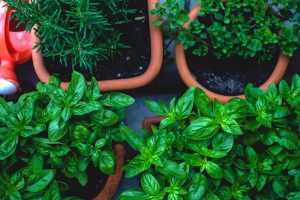 It’s possible, and indeed fairly easy, to grow your own produce even without a garden. So long as you look after your plants and give them water, soil and light as a bare minimum, they will grow. If you don’t have a garden, perhaps you have a small courtyard or patio where you can grow in containers. If you don’t have any outside areas at all, you can grow in flower pots and other containers on window sills, balconies, under skylights and so on. This makes growing produce possible almost anywhere, including in urban London in high-rise flats. After all, it’s in a plant’s nature to want to grow.
It’s possible, and indeed fairly easy, to grow your own produce even without a garden. So long as you look after your plants and give them water, soil and light as a bare minimum, they will grow. If you don’t have a garden, perhaps you have a small courtyard or patio where you can grow in containers. If you don’t have any outside areas at all, you can grow in flower pots and other containers on window sills, balconies, under skylights and so on. This makes growing produce possible almost anywhere, including in urban London in high-rise flats. After all, it’s in a plant’s nature to want to grow.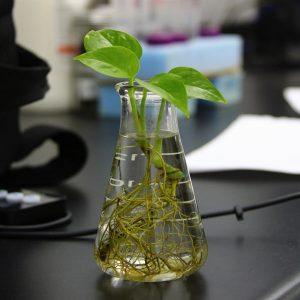 Children could start with green onions or spring onions. These are particularly easy to ‘re-grow’. Later, perhaps, the children can apply the same approach to celery, lemon grass, Cos lettuce and Pak Choy (a type of Chinese cabbage). Simply save an inch or so thick section of your shop-bought root vegetables (perhaps the last you will ever need to buy), which includes the bottom part at the root end. All your children need to do is to place that section, root end downwards, in a glass of water. Leave them in the water and, after somewhere between 1 and 3 weeks, roots will start growing. Children will love monitoring this process each day and they will enjoy looking after and caring for a living thing. Once the roots are substantial enough, children can take them out of the glass and re-pot them in soil, ideally with a bit of compost if you have any. This can be in containers, appropriately sized flower pots or in the garden if you have access to one. Before long, your plants will give your children more, free herbs and vegetables that you can all enjoy.
Children could start with green onions or spring onions. These are particularly easy to ‘re-grow’. Later, perhaps, the children can apply the same approach to celery, lemon grass, Cos lettuce and Pak Choy (a type of Chinese cabbage). Simply save an inch or so thick section of your shop-bought root vegetables (perhaps the last you will ever need to buy), which includes the bottom part at the root end. All your children need to do is to place that section, root end downwards, in a glass of water. Leave them in the water and, after somewhere between 1 and 3 weeks, roots will start growing. Children will love monitoring this process each day and they will enjoy looking after and caring for a living thing. Once the roots are substantial enough, children can take them out of the glass and re-pot them in soil, ideally with a bit of compost if you have any. This can be in containers, appropriately sized flower pots or in the garden if you have access to one. Before long, your plants will give your children more, free herbs and vegetables that you can all enjoy.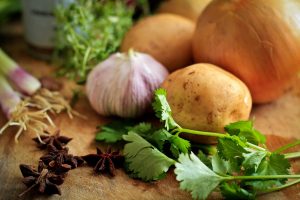 Garlic cloves are also incredibly easy to regrow in a similar way. Perhaps at some point you’ve unintentionally allowed your shop-bought garlic cloves to ‘sprout’. Well, that’s how to start off. Rather than discarding them, your children can put them in water and allow roots to grow. Then, they should plant them out in soil and eventually they’ll end up with more, free, garlic cloves. What’s more, they will tend to taste more mild and delicate than shop-bought garlic — children will probably appreciate that. It’s the same with ginger roots, but allow months rather than weeks in their case.
Garlic cloves are also incredibly easy to regrow in a similar way. Perhaps at some point you’ve unintentionally allowed your shop-bought garlic cloves to ‘sprout’. Well, that’s how to start off. Rather than discarding them, your children can put them in water and allow roots to grow. Then, they should plant them out in soil and eventually they’ll end up with more, free, garlic cloves. What’s more, they will tend to taste more mild and delicate than shop-bought garlic — children will probably appreciate that. It’s the same with ginger roots, but allow months rather than weeks in their case.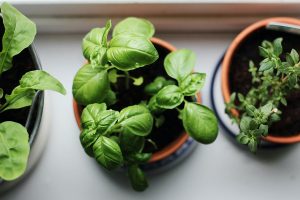 Herbs like Coriander, Rosemary and Basil can also be re-grown. Children can simply take scraps or clippings (4 inches long in the case of basil, 2-3 inches in the case of Rosemary) and place them in glasses of water in a well-lit spot on the windowsill. Once they have sprouted roots of about 2 or so inches long, these young ‘plants’ can be transplanted into soil or compost in pots. Your child will then be able to watch the plants flourish and grow into new herbs that can be harvested for food later on. The children will also soon discover that each of these herbs has a wonderful and distinctive taste and smell.
Herbs like Coriander, Rosemary and Basil can also be re-grown. Children can simply take scraps or clippings (4 inches long in the case of basil, 2-3 inches in the case of Rosemary) and place them in glasses of water in a well-lit spot on the windowsill. Once they have sprouted roots of about 2 or so inches long, these young ‘plants’ can be transplanted into soil or compost in pots. Your child will then be able to watch the plants flourish and grow into new herbs that can be harvested for food later on. The children will also soon discover that each of these herbs has a wonderful and distinctive taste and smell.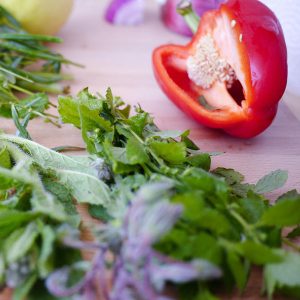 Later, when growing sprouts reach the surface, the child should keep those covered with soil (this is called ‘hilling’). Get your child to keep the soil moist but not over-saturated over the subsequent weeks. If planted in the spring, your children should be able to harvest potatoes in the summer.
Later, when growing sprouts reach the surface, the child should keep those covered with soil (this is called ‘hilling’). Get your child to keep the soil moist but not over-saturated over the subsequent weeks. If planted in the spring, your children should be able to harvest potatoes in the summer. Then, of course, your children can also experiment with nursery bought, or mail order seeds. Although not free, they’re reasonably inexpensive and also fun for children to grow if you follow the instructions and timing suggested on the seed packets. Beans of various kinds and sugar snaps are particularly easy to grow and usually result in an excellent crop. They will benefit from being in a garden or outdoor patio area, ideally, due to the space they require. They will need more vertical space than horizontal space, however, so even balcony planting may be possible if you have suitable grow bags.
Then, of course, your children can also experiment with nursery bought, or mail order seeds. Although not free, they’re reasonably inexpensive and also fun for children to grow if you follow the instructions and timing suggested on the seed packets. Beans of various kinds and sugar snaps are particularly easy to grow and usually result in an excellent crop. They will benefit from being in a garden or outdoor patio area, ideally, due to the space they require. They will need more vertical space than horizontal space, however, so even balcony planting may be possible if you have suitable grow bags.